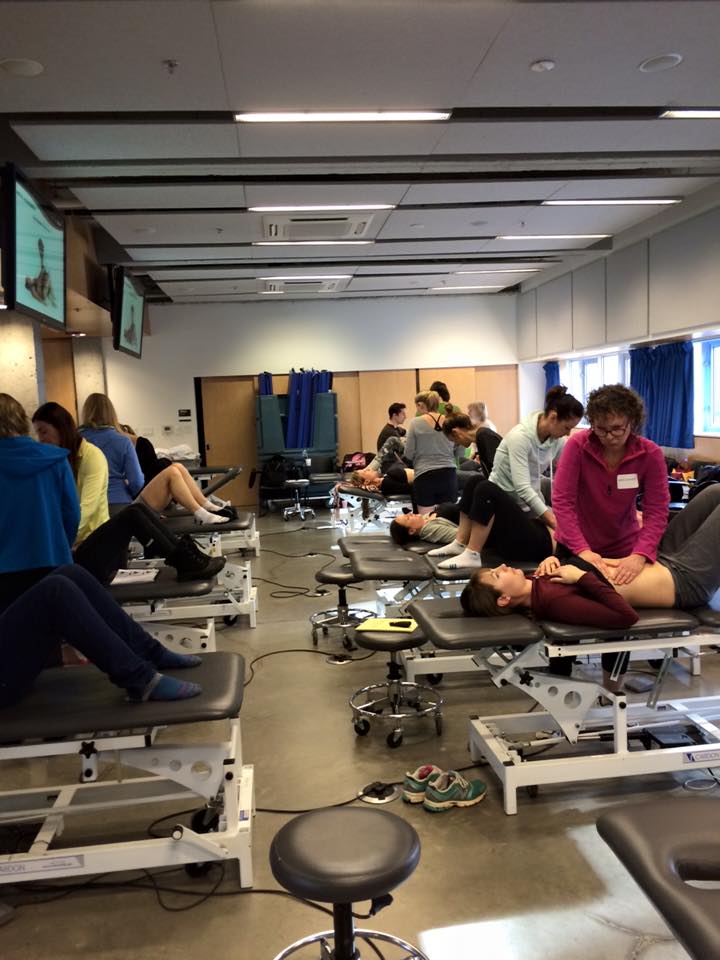What if we could address pelvic floor issues with only postures and breath?
On Mar 5 & 6th, 2016, PABC hosted Trista Zinn & Tamara Rial (Phd), as instructors for “Hypopressives/Low Pressure Fitness for Pelvic Health” at the University of British Columbia (UBC). Many who attended the course were pelvic floor rehab specialists. Many who attended the course also had personal reasons for being there. If our current pelvic/core rehab model is effective, why are there physios with prolapses, cystoceles and pessaries? It seems we’re still looking for the ‘right’ answer.
The Hypopressive Theory is based on the concept that the abdominal pressures we generate with curl-ups, planks, jumping and Pilates-type strengthening are often too great for the pelvic floor. As a consequence, we are literally pushing our organs out the bottom. The intention of the Hypopressive exercise is to generate negative pressures in the abdominal cavity to literally traction the pelvic organs upwards, enabling the pelvic floor and Transversus Abdominus to work in shortened ranges. Low Pressure Fitness training is a global approach to the core/pelvic floor. It is not based on strength of the pelvic floor on its own, but concentrates on the function of the pelvic floor’s intricate relationship with the core as a whole. The other significant difference between traditional pelvic floor strengthening and the Hypopressive (low pressure) exercise is Type II muscle fiber recruitment. The key core muscles are 70% slow twitch fibers, which increase their volume and recruitment only with sustained contraction, (unlike a Kegel which emphasizes reps/sets with resting phases – type I fiber training).
Along with serratus anterior and posterior, multifidi, the thoraco-dorsal fascia, transversus abdominus, and the pelvic floor, the real key player in these exercises is the diaphragm. Using rib and diaphragm mobilization techniques, we free up the rib cage to enable improved lateral costal breathing. Then, the patient is instructed through a combination of spinal stabilization cues that are sustained, aiming to pull the diaphragm’s central tendon upwards. In the exhalation phase, relaxation and lengthening of the diaphragm occur. At this point the patient performs a prolonged apnea, drawing the abdomen inwards and upwards, whilst maintaining the postural cues. The exercises progress to a series of sustained poses with the apnea, some of which are capable of generating negative 20-30 mm Hg as measured in the pelvic floor. In first attempts, the exercise is very challenging, and requires repeated cueing by the therapist. However with repeated practice it becomes comfortable and habit-forming.
The list of conditions which will benefit from this technique include, but are not limited to: urinary incontinence, uterine/bladder prolapse, erectile dysfunction, fibroids, hemorrhoids, pelvic pain, nocturia, cervical cell dysplasia, rectus diastasis, inguinal and abdominal hernias, constipation and low back pain. It is estimated that greater than 40% of women experience pelviperineal pathophysiology, and low back pain incidence is twice that. Other beneficial effects include improved alignment and postural stabilization, increased lumbar mobility, increased hamstring expandability, decreased cervical and lumbar lordoses, decreased thoracic kyphosis and scoliosis correction. Waistlines also shrink, which explains why the Europeans are keen to integrate the technique.
This is an invaluable tool which not only has the potential to generate above average results with our pelvic health patients, but also has the ability to transform our entire client population. It is a risk free, preventative, global exercise system, which improves well-being, aesthetics and physical performance. If spinal health is a measure of our longevity, the Hypopressive technique is a ‘game changer’. Become an instructor – let’s generate a Canadian wide Low Pressure Fitness movement. We will be the new kid on the block and our patients will shine.
Acknowledgements
We would like to thank Katharine Hasz and PACB sharing this letter with Low Pressure Fitness after attending Level 1 LPF course in Vancouver.
Katharine Hasz Physical Therapist,
currently lives in Tofino, B.C., with a home-based practice, integrating manual therapy, acupuncture, cranio-sacral and visceral techniques. LPF leve 1 trainer.
